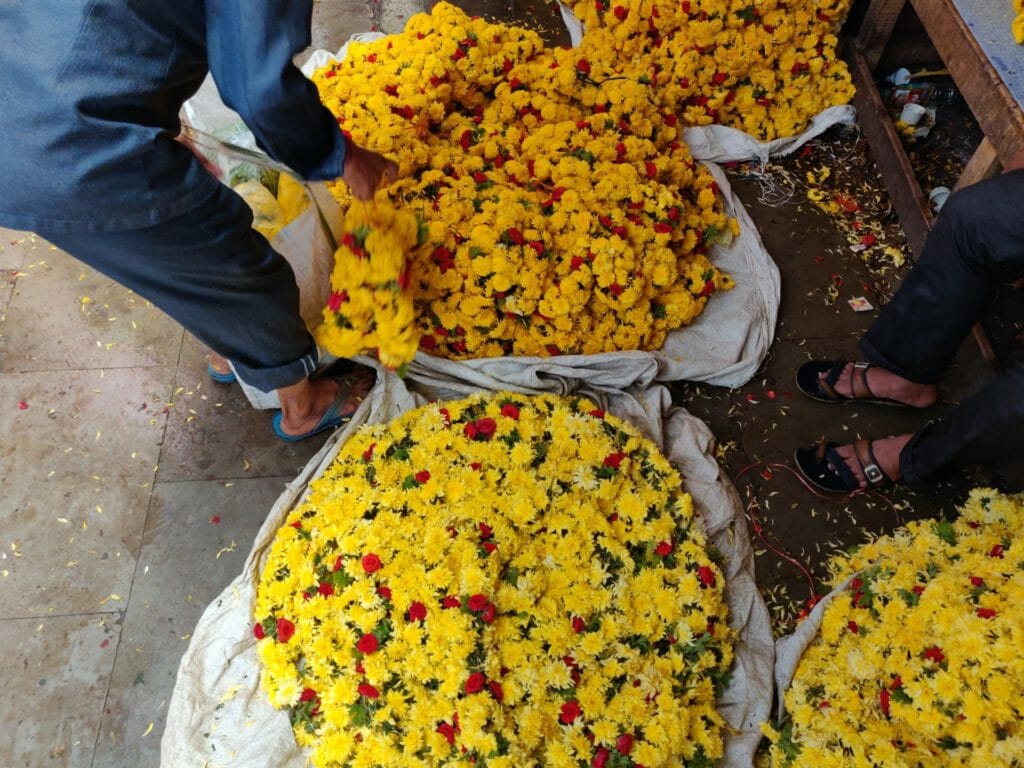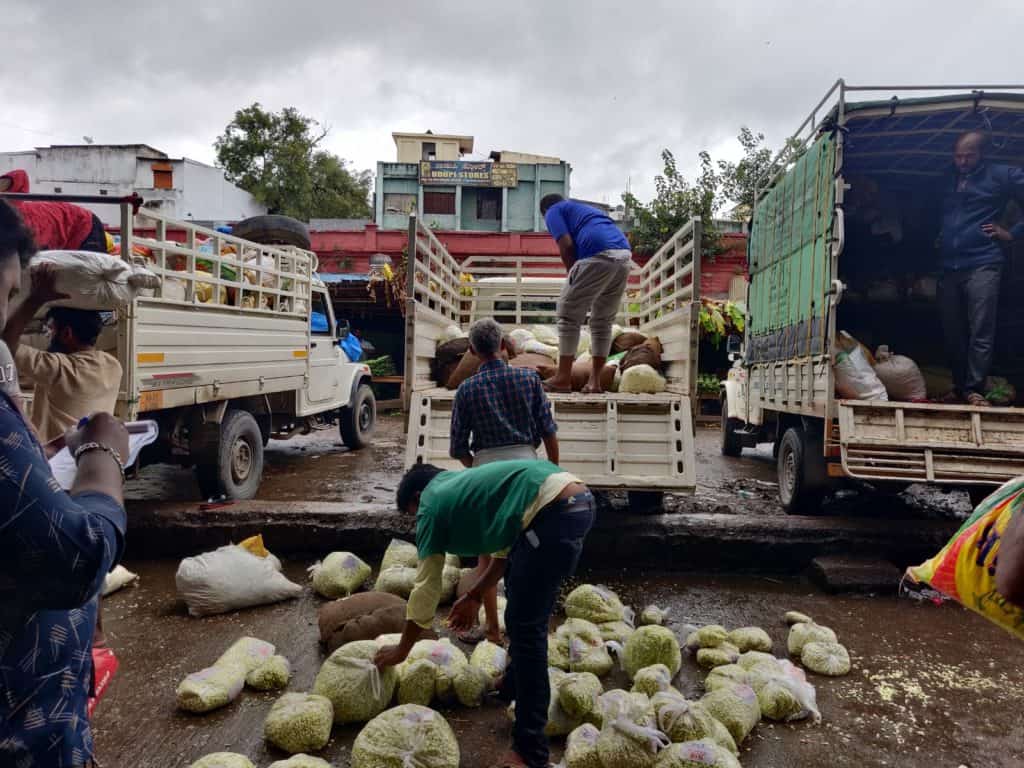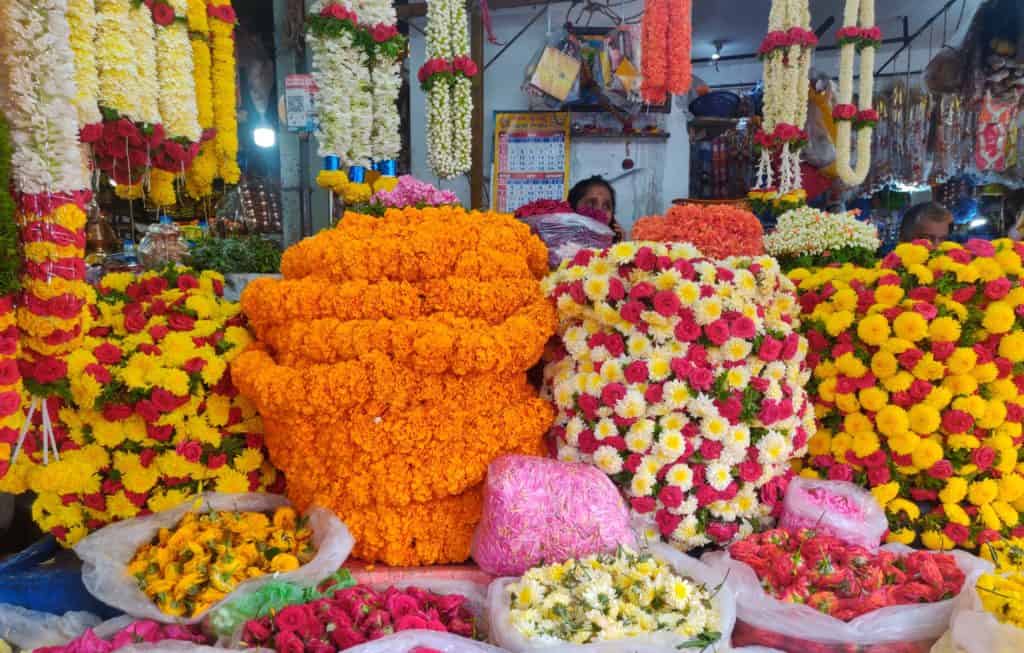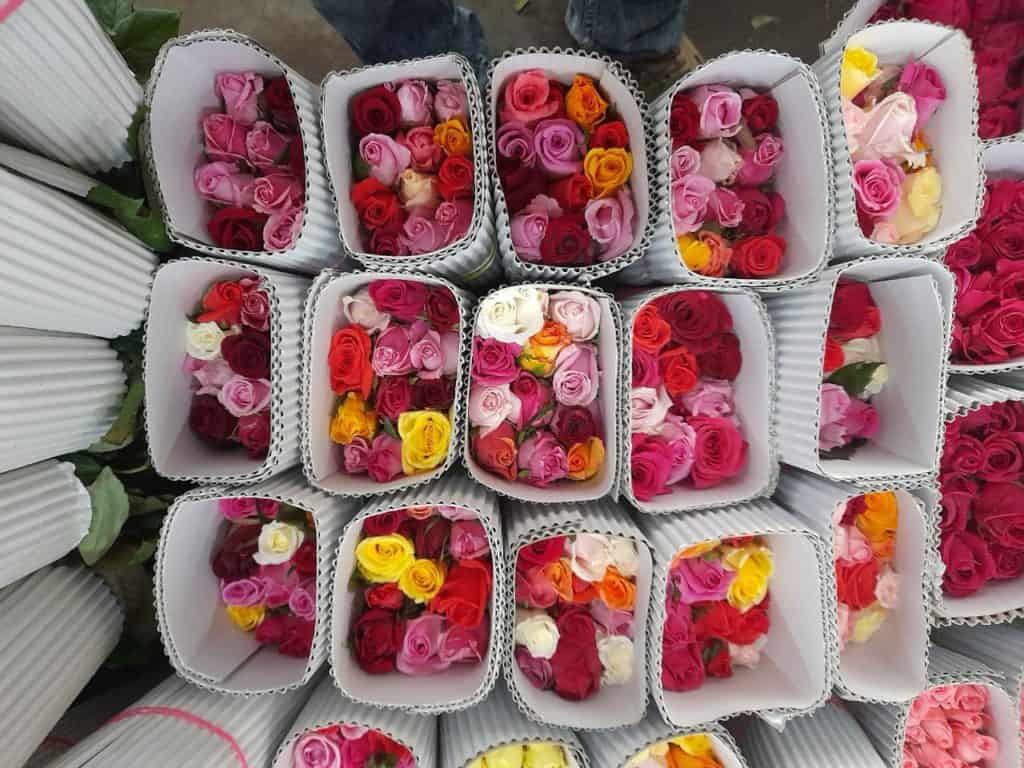Amidst a cacophony of chants of “ond maaru nalvattu” (one measure Rs 40), every morning the city’s Krishna Rajendra Market wears a vibrant cloak of reds, orange and yellow. The removal of all COVID restrictions has made the flower market even more colourful and cacophonous, as this year’s festival season gets underway.
Amidst negotiating a kucchu (bunch) of fully bloomed chrysanthemums from Rs 140 down to Rs 100, Naveen Kumar, a flower seller in KR Market for 17 years, is seeing an uptick in his sales during the weeks leading up to Varamahalaxmi, Dussehra, Ganesh Chaturti and Ugadi. “I earn up to Rs 2,000-3,000 a day, rest of the month it is down to Rs 500-600,” says Naveen, who sells only chrysanthemums.
Naveen buys his daily quota of around 70-80 kgs of flowers from from Madhugiri mandi near Tumkur district 120 km away and is able to sell the entire stock. “Vendors in KR Market have over the years established a strong relationship with farmers and mandis across Sakleshapura, Hassan, Udupi, Mangalore, Karkala and Mysore,” says Naveen.

Unfortunately, in its rush to be described as India’s silicon valley, much has been forgotten about the garden city’s historic connection with the floral trade that has helped sustain farmers from various parts of southern India. The city’s main market has been a common meeting point for buyers and sellers from near and far for decades now.
But where does Bengaluru get its flowers from?
Peri-urban areas of Bengaluru are characterised by several small and medium industries, moderate housing options and vast swathes of agricultural lands. This has been an effective production landscape as floriculture and cultivation of flowers need large land tracts and lots of water.
A working paper by Azim Premji University documented how these areas are dotted with ‘polyhouses’ that grow high-value flowers exclusively for the city’s well-established flower trade. For instance, quoting data from 2015, the paper mentions that 15% of the land in Anekal Taluk and 7% of the land in Devanahalli are used to cultivate flowers.
Being a market-oriented product, flower crops have a high income-earning potential. Traditional flower crops comprise chrysanthemum, jasmine, crossandra, rose, tuberose, aster, marigold and champaka. Their modern counterparts are roses, gerbera, carnation, etc. The former has a wider consumer base at the city’s main market, especially during traditional festivals.
KR Market the hub
Besides farm-owners outside Bengaluru city, cultivators across south India transport their harvest to KR Market. Murugan S acts as a liaison between local suppliers in Tamil Nadu and the vendors at the market. “They (the suppliers) arrange for the flowers to be transported to the market, I take a count before selling them to the vendors here” says Murugan. “Irrespective of the season, whatever is supplied always gets sold”.

Jaya V and other vendors get their steady supply of flowers from middlemen like Murugan. Jaya, a second-generation flower seller at KR Market selling a wide variety of flowers in her stand, says the liaisons also transport flowers from Nelamangala, Chikkaballapura and other areas outside the city. She buys what she needs at Rs 60-70/kg and sells them at Rs 30-40 for quarter kilogram.
According to her, the festival season from August-September and the wedding season in May-June are the most profitable during which she and her fellow vendors are at times able to earn a daily revenue of Rs 20,000 as opposed to Rs 5,000 on a regular day.
She says her customers vary from individuals to other vendors buying at wholesale rates. “They buy at wholesale rates in KR Market, and go back and sell them at higher rates at city localities like Banashankari, Sarakki and Hoskete markets”.
Read More: Gifting flowers? Get a glimpse into Huvina Mandi
The smaller markets
Chandrakala, a flower vendor at Sarakki market tells a different story. “We sell the flowers at merely Rs 10-15 higher than the price we buy them at the market, which barely covers travel expenses,” she says, Chandrakala brings the flowers she buys at KR Market to Sarakki by auto daily. Unlike Jaya, she says business has been erratic and she doesn’t see it improving during the festive season.

Nagaveni S, another flower vendor who has had her flower stand outside Banashankari temple for two decades now, says the festival season does not make a big difference to her business. Temple-goers buy flowers regularly from her and once a week, the staff at the temple buy in bulk.
Both the vendors source their flowers from the city market and transport them in autos daily. Both bring the flowers early in the morning. Nagaveni’s customer usually come earlier in the day before they visit the temple. Every Friday the temple buys her flowers in bulk. KR Market is thus the common point to distribute flowers to roadside vendors across the city.
The export market
As far as state-wise data, existing research attests to India’s thriving floriculture segment, with Bangalore International Airport being one of the major exporting centres. This acclaim also boosted the cut-flower industry in Bangalore after it held its first international flower auction in 2007 in Hebbal.

The auction, held once a year around February, attracts farmers in Karnataka, Andhra Pradesh and Tamil Nadu and their buyers vary from individuals or agents who further sell them across metropolitan cities like Delhi, Kolkata, Hyderabad, Chennai, etc. “Bengaluru was chosen as a conducive location for this as it is among the best places to grow roses” said an official from the International Flower Auction Bengaluru (IAFB) on condition of anonymity.
IAFB is a joint venture by public and private shareholders aimed at supplying to domestic and international markets. In the financial year ending in March 2021, the auction generated a revenue of Rs 2.96 crores.
The auction features exotic cut flowers ranging from roses, carnations, gerbera, birds of paradise, etc with 90% of sales dominated by varieties of roses. Especially ahead of holidays like Mother’s day, Valentine’s day, New Years, Christmas and Teacher’s day.
Bengaluru continues to be one of the biggest markets for farmers in the Nilgiris, especially those bringing in varieties for the annual flower show held in Lalbagh ahead of Independence Day. Kusuma G, deputy director of Lalbagh Botanical Garden admitted that none of the flowers for the show come from within the city. Apart from the plants grown within the garden, most flowers come from Ooty, Kolkata and Chikkaballapura except for some cut-stem roses sourced within the city. “We have a few Dutch varieties, bromeliads and tulips from Holland and at least five different shades of Hydrangeas”.
With the flower show now back after a two year back, and fear of COVID lessening, it is beginning to be business as usual for Bengaluru’s sellers and buyers.